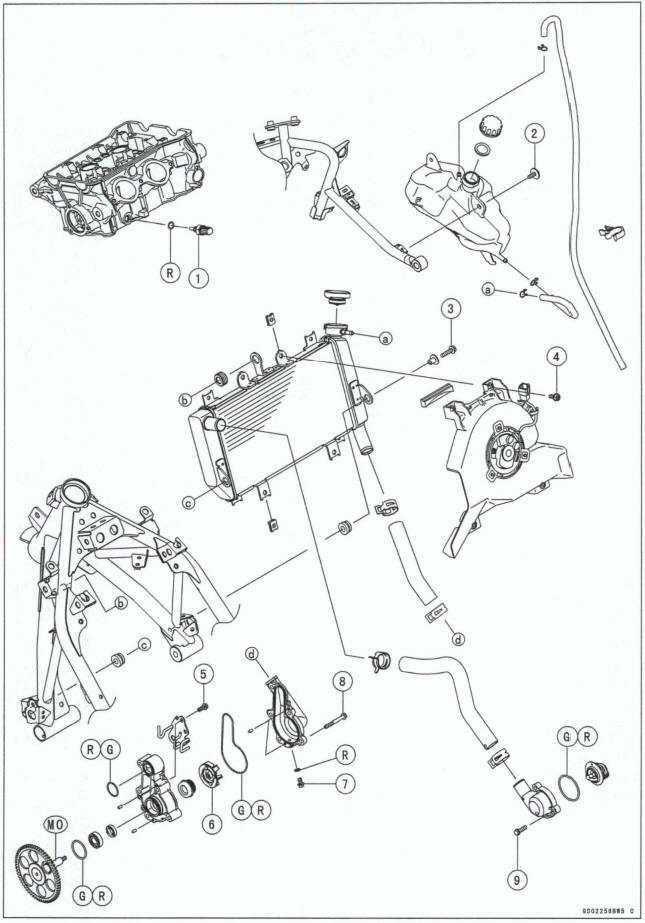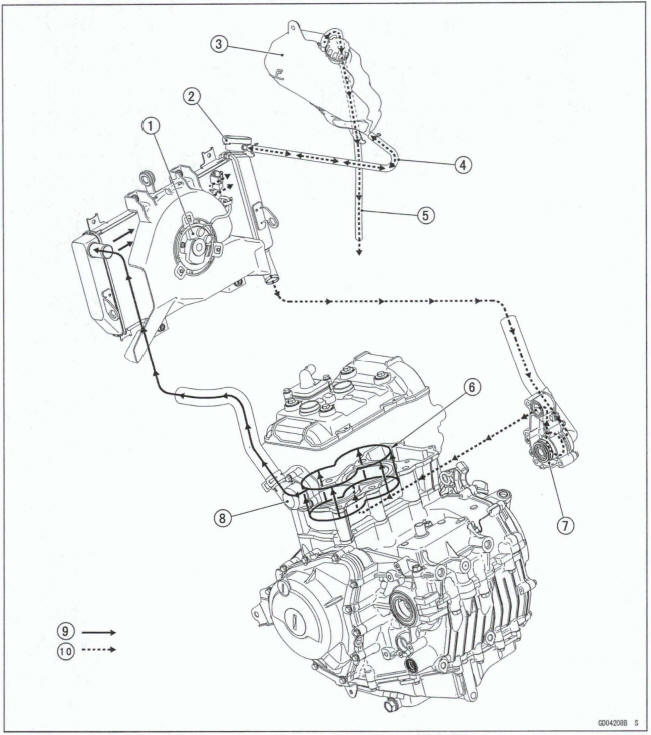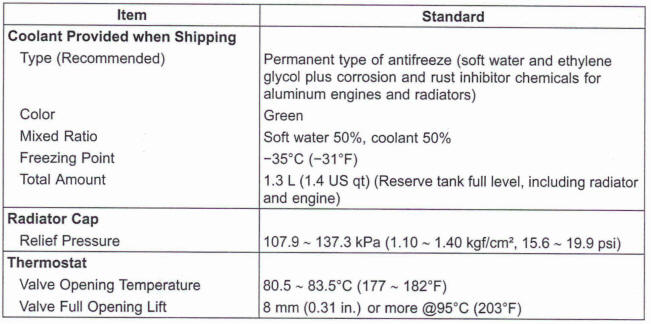 Kawasaki Z400 - Service manual > Cooling System
Kawasaki Z400 - Service manual > Cooling System
Exploded View


G: Apply grease.
MO: Apply molybdenum disulfide oil solution. (mixture of the engine oil and molybdenum disulfide grease in a weight ratio 10:l)
R: Replacement Parts
Coolant Flow Chart

- Radiator Fan
- Radiator Cap
- Reserve Tank
- Radiator Overflow Hose
- Reserve Tank Overflow Hose
- Cylinder Head Water Jacket
- Water Pump
- Thermostat Housing
- Hot Coolant
- Cold Coolant
Permanent type antifreeze is used as a coolant to protect the cooling system from rust and corrosion.
When the engine starts, the water pump turns and the coolant circulates.
The thermostat is a wax pellet type which opens or closes with coolant temperature changes. The thermostat continuously changes its valve opening to keep the coolant temperature at the proper level.
When coolant temperature is less than 80.5 ~ 83.5ºC (177 - 182ºF), the thermostat doses so that the coolant flow is restricted through the air bleeder hole, causing the engine to warm up more quickly.
When coolant temperature is more than 80.5 ~ 83.5ºC (177 - 182ºF), the thermostat opens and the coolant flows.
When the coolant temperature goes up beyond 104ºC (219ºF), the radiator fan relay conducts to operate the radiator fan. The radiator fan draws air through the radiator core when there is not sufficient air flow such as at low speeds. This increases up the cooling action of the radiator. When the coolant temperature is below 99ºC (210ºF), the fan relay opens and the radiator fan stops.
In this way, this system controls the engine temperature within narrow limits where the engine operates most efficiently even if the engine load varies.
The system is pressurized by the radiator cap to suppress boiling and the resultant air bubbles which can cause engine overheating. As the engine warms up, the coolant in the radiator and the water jacket expands. The excess coolant flows through the radiator cap and hose to the reserve tank to be stored there temporarily. Conversely, as the engine cools down, the coolant in the radiator and the water jacket contracts, and the stored coolant flows back to the radiator from the reserve tank The radiator cap has two valves. One is a pressure valve which holds the pressure in the system when the engine is running. When the pressure exceeds 107.9 ~ 137.3 kPa (1.10 ~ 1.40 kgf/cm2, 15.6 ~ 19.9 psi), the pressure valve opens and releases the pressure to the reserve tank. As soon as pressure escapes, the valve doses, and keeps the pressure at 107.9 ~ 137.3 kPa (1.10 ~ 1.40 kgf/cm2, 15.6 ~19.9 psi). When the engine cools down, another small valve (vacuum valve) in the cap opens. As the coolant cools, the coolant contracts to form a vacuum in the system. The vacuum valve opens and allows the coolant from the reserve tank to enter the radiator
Specifications

See also:
 Kawasaki Z400 - Service manual > Fuel Tank
Kawasaki Z400 - Service manual > Fuel Tank
Fuel Tank Removal WARNING Gasoline is extremely flammable and can be explosive under certain conditions, creating the potential for serious bums. Make sum the area Is well ventilated and free from any source of flame or sparks; this includes any appliance with a pilot light. Do not smoke. Turn the ignition switch off. Disconnect the battery (-)terminal. To avoid fuel spills, draw it from the tank when the engine b cold. E4a prepared for fuel spillage; any spilled fuel must be completely wiped up immediately. Turn the ignition switch off. Wait until the engine cools down. Disconnect the battery (-) terminal (see Battery Removal in the Electrical System chapter). Remove: Seats (Rear/Front Seat Removal in the Frame chapter) Middle Fairings (see Middle Fairing Removal in the Frame chapter) Remove the bolt [A] on both sides. Clear the projection [B] of the upper inner fairing to the grommet on both sides. Slide the damps [A]. Disconnect: Drain Hose [B] Breather Hose [C] Remove: Fuel Tank Bolts [A] Bracket [B] Disconnect the fuel pump lead connector [A]. Open the fuel tank cap [A] to lower the pressure In the tank. During tank removal, keep the tank cap open to release pressure in the tank. This makes fuel spillage less. Draw the fuel out from the fuel tank with a commercially available pump [A].
 Kawasaki Z400 - Service manual > Coolant
Kawasaki Z400 - Service manual > Coolant
Coolant Deterioration Inspection Remove the right middle fairing (see Middle Fairing Removal in the Frame chapter). Visually inspect the coolant in the reserve tank [A].

 Benelli Imperiale 400
Benelli Imperiale 400 BMW F900XR
BMW F900XR Honda CB500X
Honda CB500X KTM 390 Adventure
KTM 390 Adventure Triumph Street Triple S
Triumph Street Triple S Yamaha MT-03
Yamaha MT-03 Kawasaki Z400
Kawasaki Z400 Triumph Street Triple S
Triumph Street Triple S Yamaha MT-03
Yamaha MT-03